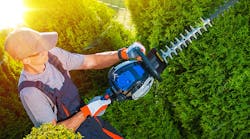Before heading to the beach or the pool, you likely consider items to bring to protect you from the sun. But what about when you’re heading to work? Skin cancer is by far the most common form of cancer and too much exposure to ultraviolet (UV) radiation increases the risk of skin cancer. Outdoor workers naturally spend more time exposed to UV radiation, putting them at greater risk of sun damage and the potential of developing skin cancers. Unfortunately, the dangers of skin cancer in the workplace have often been neglected.
Employers have an obligation to minimize the risk of harm to employees. Providing and encouraging sun protection for outdoor workers can help create a healthy and safe workplace.
Practice the Five S’s
Every year, according to the CDC, Americans lose more than $100 million in productivity because of restricted activity or absence from work due to skin cancer. Most skin cancers are preventable when best practices are followed. Consider the five S’s of sun safety when it comes to protecting workers from UV exposure.
1. Slip on sun protective clothing. Clothing can be one of the most effective barriers between our skin and the sun because it absorbs or blocks much of the UV radiation. It’s important for clothing to cover as much skin as possible. Certain areas, such as shoulder, can easily burn, so always keep them covered. Additionally, a fabric with closer weave will provide more protection.
There are also sun protection factor (SPF)-rated fabrics that provide protection from the sun. For example, a shirt with an SPF of 50 allows just 1/50th of the sun’s UV radiation to reach the skin.
2. Slop on sunscreen. Your sunscreen should be a minimum of SPF 30 or above and preferably water-resistant. It should also cover all bases, protecting against harmful UV-A and UV-B rays as well as the artificial UV-C rays created by industrial processes such as welding. Occupational sunscreens are available that can be quickly and easily absorbed as to not affect dexterity with hand-held tools. Perfume-free options also help reduce the potential for allergic reaction and skin irritation.
Sunscreen should be applied to exposed skin 20 minutes before going outdoors. Reapplication is crucial too; it is recommended that sunscreen be reapplied liberally every two to three hours.
3. Slap on a hat. Hats with a wide brim cover places that are difficult to apply sunscreen, including the scalp and ears. A hat also provides additional protection for the face and neck. You should also consider hats made with SPF materials.
4. Slide on quality sunglasses. UV radiation from the sun can damage not only the skin of your eyelid but also the cornea, lens and other parts of the eye. To protect your eyes, look for sunglasses that block 99% to 100% of both UVA and UVB rays, and screen out 75% to 90% of visible light.
It’s important to note that the color and degree of darkness sunglasses provide have nothing to do with the sunglasses’ ability to block UV rays. You can also opt for wraparound sunglasses or close-fitting sunglasses with wide lenses that protect your eyes from every angle.
Although some contact lenses also offer UV protection, they should be worn in combination with sunglasses to maximize protection.
5. Shade from the sun whenever possible. Shade can provide a good barrier between our skin and the sun, so it’s crucial to seek shade whenever possible, particularly at the hottest times of the day between 11 a.m. and 3 p.m. when UV penetration is strongest. Some outside jobs can be done inside or in a shaded area. If not, consider erecting a temporary shelter for protection. You can also reorganize the schedule so that outside tasks can be completed in the morning before 11 a.m. or after 3 p.m. Even if you’re working in the shade, you should still use other personal protection measures, such as sunscreen.
From landscapers to construction workers to postal workers, outdoor workers have a higher than average risk of skin cancer. However, even occupations such as truck drivers are at risk. The levels of UV radiation inside a car vary. Although laminated windscreens, which are made of a tough plastic layer bonded between two panes of glass, have SPF ratings of at least 50, the plain window glass used in car side windows is usually about a SPF 12, which provides only moderate protection unless clear or tinted film is applied. That means a person sitting in a car should be wearing sun protection.
Beat the Heat: Implement Sun Safety Measures
According to the Occupational Safety and Health Act, employers have a responsibility to ensure employees are provided a safe working environment. Addressing sun safety is an essential part of this. Despite being almost entirely preventable, the American Academy of Dermatology estimates that more than 8,500 people in the U.S. are diagnosed with skin cancer every day. When it comes to health in the workplace, prevention is far better than cure.
The most effective way for employers to protect employees from contracting skin cancer is to provide sun safety measures in the workplace. Implementing a comprehensive sun protection program, which includes a range of simple protective measures, can prevent sun-related injuries and reduce the suffering and costs associated with skin cancer—including reduced productivity.
Isabelle Faivre is VP of marketing with Deb USA. As part of its Be UV Aware campaign, Deb offers tools to help employers implement a suitable and successful sun safety policy to protect its workers.
